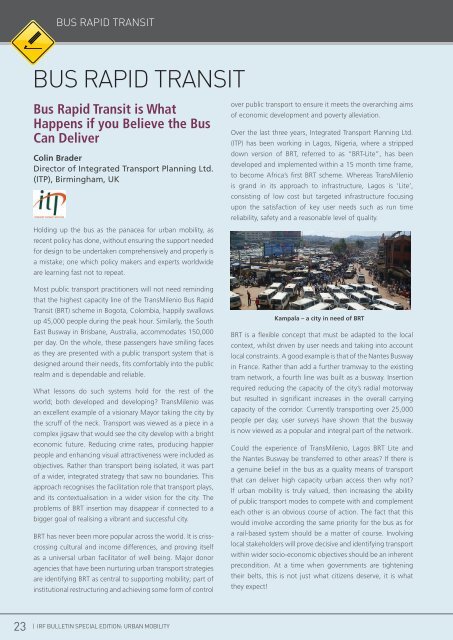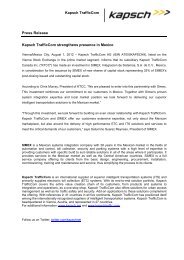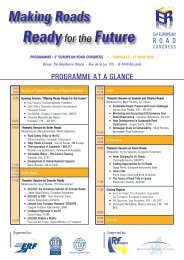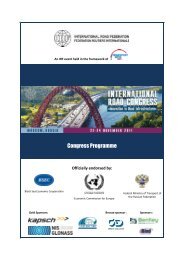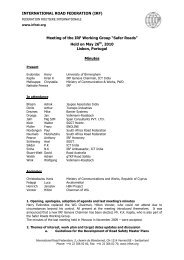Motorways and Urban Mobility - International Road Federation
Motorways and Urban Mobility - International Road Federation
Motorways and Urban Mobility - International Road Federation
Create successful ePaper yourself
Turn your PDF publications into a flip-book with our unique Google optimized e-Paper software.
23<br />
BUS RAPID TRANSIT<br />
BUS RAPID TRANSIT<br />
Bus Rapid Transit is What<br />
Happens if you Believe the Bus<br />
Can Deliver<br />
Colin Brader<br />
Director of Integrated Transport Planning Ltd.<br />
(ITP), Birmingham, UK<br />
Holding up the bus as the panacea for urban mobility, as<br />
recent policy has done, without ensuring the support needed<br />
for design to be undertaken comprehensively <strong>and</strong> properly is<br />
a mistake; one which policy makers <strong>and</strong> experts worldwide<br />
are learning fast not to repeat.<br />
Most public transport practitioners will not need reminding<br />
that the highest capacity line of the TransMilenio Bus Rapid<br />
Transit (BRT) scheme in Bogota, Colombia, happily swallows<br />
up 45,000 people during the peak hour. Similarly, the South<br />
East Busway in Brisbane, Australia, accommodates 150,000<br />
per day. On the whole, these passengers have smiling faces<br />
as they are presented with a public transport system that is<br />
designed around their needs, fits comfortably into the public<br />
realm <strong>and</strong> is dependable <strong>and</strong> reliable.<br />
What lessons do such systems hold for the rest of the<br />
world; both developed <strong>and</strong> developing? TransMilenio was<br />
an excellent example of a visionary Mayor taking the city by<br />
the scruff of the neck. Transport was viewed as a piece in a<br />
complex jigsaw that would see the city develop with a bright<br />
economic future. Reducing crime rates, producing happier<br />
people <strong>and</strong> enhancing visual attractiveness were included as<br />
objectives. Rather than transport being isolated, it was part<br />
of a wider, integrated strategy that saw no boundaries. This<br />
approach recognises the facilitation role that transport plays,<br />
<strong>and</strong> its contextualisation in a wider vision for the city. The<br />
problems of BRT insertion may disappear if connected to a<br />
bigger goal of realising a vibrant <strong>and</strong> successful city.<br />
BRT has never been more popular across the world. It is crisscrossing<br />
cultural <strong>and</strong> income differences, <strong>and</strong> proving itself<br />
as a universal urban facilitator of well being. Major donor<br />
agencies that have been nurturing urban transport strategies<br />
are identifying BRT as central to supporting mobility; part of<br />
institutional restructuring <strong>and</strong> achieving some form of control<br />
| IRF BULLETIN SPECIAL EDITION: URBAN MOBILITY<br />
over public transport to ensure it meets the overarching aims<br />
of economic development <strong>and</strong> poverty alleviation.<br />
Over the last three years, Integrated Transport Planning Ltd.<br />
(ITP) has been working in Lagos, Nigeria, where a stripped<br />
down version of BRT, referred to as “BRT-Lite”, has been<br />
developed <strong>and</strong> implemented within a 15 month time frame,<br />
to become Africa’s first BRT scheme. Whereas TransMilenio<br />
is gr<strong>and</strong> in its approach to infrastructure, Lagos is ‘Lite’,<br />
consisting of low cost but targeted infrastructure focusing<br />
upon the satisfaction of key user needs such as run time<br />
reliability, safety <strong>and</strong> a reasonable level of quality.<br />
Kampala – a city in need of BRT<br />
BRT is a flexible concept that must be adapted to the local<br />
context, whilst driven by user needs <strong>and</strong> taking into account<br />
local constraints. A good example is that of the Nantes Busway<br />
in France. Rather than add a further tramway to the existing<br />
tram network, a fourth line was built as a busway. Insertion<br />
required reducing the capacity of the city’s radial motorway<br />
but resulted in significant increases in the overall carrying<br />
capacity of the corridor. Currently transporting over 25,000<br />
people per day, user surveys have shown that the busway<br />
is now viewed as a popular <strong>and</strong> integral part of the network.<br />
Could the experience of TransMilenio, Lagos BRT Lite <strong>and</strong><br />
the Nantes Busway be transferred to other areas? If there is<br />
a genuine belief in the bus as a quality means of transport<br />
that can deliver high capacity urban access then why not?<br />
If urban mobility is truly valued, then increasing the ability<br />
of public transport modes to compete with <strong>and</strong> complement<br />
each other is an obvious course of action. The fact that this<br />
would involve according the same priority for the bus as for<br />
a rail-based system should be a matter of course. Involving<br />
local stakeholders will prove decisive <strong>and</strong> identifying transport<br />
within wider socio-economic objectives should be an inherent<br />
precondition. At a time when governments are tightening<br />
their belts, this is not just what citizens deserve, it is what<br />
they expect!


